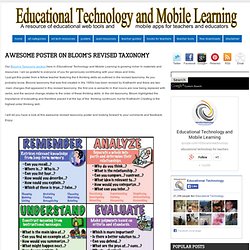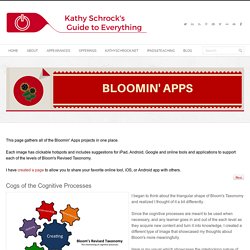

UF 20: "Objetivo BOE 2020"(Metodologías activas de aula: ABP y clase invertida) - Unidades formativas 2014 - 2015. Aprendizaje basado en problemas: otra manera de descubrir el mundo. ¿Qué es el aprendizaje basado en problemas?

El aprendizaje basado en problemas es un método que se basa en que el alumno aprenda a resolver los problemas que se le plantean de acuerdo con los recursos adquiridos. Uno de los principios básicos de este método es que los alumnos refuezan los conocimientos aprendidos a partir del desarrollo de su propio razonamiento crítico. La ya habitual pregunta ‘¿para qué nos va a servir aprender esto?’ Encuentra en esta metodología una eficaz respuesta: resolver problemas utilizando la materia estudiada permite dar sentido a esos conocimientos que aún están por adquirir, junto con los anteriores. Se tiende a pensar que se trata de un sistema únicamente aplicable a la asignatura de Matemáticas, pero nada más lejos de la realidad. ¿En qué consiste el aprendizaje basado en problemas? El objetivo del aprendizaje basado en problemas (PBL) es que el alumno descubra qué necesita aprender para resolver un determinado problema que se propone.
Blooms Taxonomy with Apps. ¿Cómo se construye el plan de estudios? - El Plan de Estudios. Achievement pathways Examples of potential pathways for learners from the broad general education through the senior phase and case studies from schools about developing the curriculum for new pathways.

Framework for assessment 'Building the Curriculum 5' provides guidance on the main areas of the assessment strategy for Curriculum for Excellence. Involving learners Putting the learner at the centre through consulting pupils on how learning should be planned. 4 impresionantes nuevas floraciones Taxonomía Posters ~ Tecnología Educativa y Aprendizaje Móvil. I have been recently engaged in expanding Blooms Taxonomy section here in Educational Technology and Mobile Learning to include new resources published for the first time.

Blooms Taxonomy for The iPad and Blooms Taxonomy for The Web are the most recent additions in this regard. I am also working on Blooms Taxonomy for Android. Some of you send me emails asking why I don't cover Android in my posts as I do with iPad ( or iOS devices ). The answer is simple , I am more used to working on and handling iPad than Android operated devices. I do love Android and I will probably give it more space in this blog this year. No se pierda la rueda Taxonomía de Bloom Este impresionante ~ Tecnología Educativa y Aprendizaje Móvil. I will be virtually presenting next Friday in MORCE.net conference.

My presentation will be on Blooms' Digital Taxonomy. This is one of the major topics of Educational Technology and Mobile Learning which I have profusely written on in previous posts. There is also a separate section in this blog devoted solely to articles and resources on everything teachers need to know about Blooms Taxonomy. Of course my focus is on the digital component of this taxonomy and hence the label Blooms Digital Taxonomy. Compared to the traditional version of Bloom's Taxonomy, vigorous research regarding the use and implementation of Digital Bloom's Taxonomy is still lacking. However, that being said, I am sharing with you today an awesome graphic on Bloom's Taxonomy Question and Task Design Wheel.I find it really useful and thought you might like to have a look. Click HERE to see the wheel in full view and download it. Tecnología Educativa y Aprendizaje Móvil: Floraciones taxonomía. Cartel impresionante de Taxonomía revisada de Bloom ~ Tecnología Educativa y Aprendizaje Móvil.
Our Bloom's Taxonomy section here in Educational Technology and Mobile Learning is growing richer in materials and resources.

I am so grateful to everyone of you for generously contributing with your ideas and links. I just got this poster from a fellow teacher featuring the 6 thinking skills as outlined in the revised taxonomy. As you probably know, Blooms taxonomy that was first created in the 1950s has been revised by Krathwohl and there are two main changes that appeared in this revised taxonomy: the first one is semantic in that nouns are now being replaced with verbs; and the second change relates to the order of these thinking skills. In the old taxonomy, Bloom highlighted the importance of evaluating and therefore placed it at the top of the thinking continuum, but for Krathwohl Creating is the highest order thinking skill.
I will let you have a look at this awesome revised taxonomy poster and looking forward to your comments and feedback. Drive. Bloomin 'Apps - Guía de Kathy Schrock a Todo. This page gathers all of the Bloomin' Apps projects in one place.Each image has clickable hotspots and includes suggestions for iPad, Android, Google and online tools and applications to support each of the levels of Bloom's Revised Taxonomy.I have created a page to allow you to share your favorite online tool, iOS, or Android app with others.

Cogs of the Cognitive Processes I began to think about the triangular shape of Bloom's Taxonomy and realized I thought of it a bit differently.Since the cognitive processes are meant to be used when necessary, and any learner goes in and out of the each level as they acquire new content and turn it into knowledge, I created a different type of image that showcased my thoughts about Bloom's more meaningfully.Here is my visual which showcases the interlocking nature of the cognitive processes or, simply, the "Cogs of the Cognitive Processes".